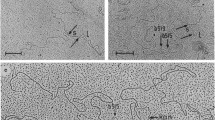Summary
The prokaryotic mercury-resistance transposon Tn501 contains a sequence, 80 nucleotides from one end, which is identical with an inverted terminal repeat (IR) of Tn21. This Tn21 IR sequence is used when Tn21 complements a TnpA- derivative of Tn501, but not when Tn501 is used for the complementation. Complementation by Tn1721 shows a preference for the normal Tn501 IRs. The element (Tn820) transposed when Tn21 is used to complement a Hg- TnpR- TnpA- Res- deletion mutant of Tn501 contains the Tn21 IR sequence at one terminus and a Tn501 IR at the other. Transposition of Tn820 can be complemented by Tn501 and Tn1721, but at a much lower frequency than transposition of the parental element (Tn819) which has two Tn501 IRs. The relationship between the transposition functions of Tn501, Tn21 and Tn1721, and available nucleotide sequence data suggest that Tn501 evolved by the transposition of a Tn21-like element into another transposable element (similar to that found within Tn1721) followed by deletion of the Tn21-like transposition functions.
Similar content being viewed by others
Abbreviations
- (IR):
-
Inverted repeat
- (Cb):
-
carbenicillin
- (Cm):
-
chloramphenicol
- (Sm):
-
streptomycin
- (Su):
-
sulphonamide
- (Tc):
-
tetracycline
- (Tp):
-
trimethoprim
References
Altenbuchner J, Choi C-L, Grinsted J, Richmond MH (1981) The transposons Tn501 (Hg) and Tn1721(Tc) are related. Genet Res Camb 37:285–289
Brown NL, Choi C-L, Grinsted J, Richmond MH, Whitehead PR (1980) Nucleotide sequences at the ends of the mercury resistance transposon Tn501. Nucl Acids Res 8:1933–1945
Brown NL, Ford SJ, Pridmore RD, Fritzinger DC (1983) Nucleotide sequence of a gene from the Pseudomonas transposon Tn501 encoding mercuric reductase. Biochemistry 22:4089–4095
de la Cruz F, Grinsted J (1982) Genetic and molecular characterization of Tn21, a multiple resistance transposon from R100.1. J Bacteriol 151:222–228
Diver WP, Grinsted J, Fritzinger DC, Brown NL, Altenbuchner J, Rogowsky P, Schmitt R (1983) DNA sequences of and complementation by the tnpR genes of Tn21, Tn501 and Tn1721. Mol Gen Genet 191:189–193
Grinsted J, Saunders JR, Ingram LG, Sykes RB, Richmond MH (1972) Properties of an R-factor which originated in Pseudomonas aeruginosa 1822. J Bacteriol 110:529–537
Grinsted J, de La Cruz F, Altenbuchner J, Schmitt R (1982) Complementation of transposition of tnpA mutants of Tn3, Tn21, Tn501 and Tn1721. Plasmid 8:276–286
Kitts P, Symington L, Burke M, Reed R, Sherratt D (1982) Transposon-specified site-specific recombination. Proc Natl Acad Sci USA 79:46–50
Kleckner N (1981) Transposable elements in prokaryotes. Annu Rev Genet 15:341–404
Misra TK, Brown NL, Fritzinger DC, Pridmore RD, Barnes WM, Haberstroh L, Silver S (1984) Meruric resistance genes of plasmid R100 and transposon Tn501: the beginning of the operon including the regulatory region and the first two structural genes. Proc Natl Acad Sci USA, in press
Rogowsky P, Schmitt R (1984) Resolution of a hybrid cointegrate between transposons Tn501 and Tn1721 defines the recombination site. Mol Gen Genet 193:162–166
Sanger F, Coulson AR, Barrell BG, Smith AJH, Roe BA (1980) Cloning in single-stranded bacteriophage as an aid to rapid DNA sequencing. J Mol Biol 143:161–178
Schmitt R, Altenbuchner J, Wiebauer K, Arnold W, Puhler A, Schöffl F (1981) Basis of transposition and gene amplification by Tn1721, and related tetracycline-resistance transposons. Cold Spring Harbor Symp Quant Biol 45:59–65
Schöffl F, Arnold W, Puhler A, Altenbuchner J, Schmitt R (1981) The tetracycline resistance transposons Tn1721 and Tn1771 have three 38-base pair repeats and generate five base pair direct repeats. Mol Gen Genet 181:87–94
Sutcliffe JG (1978) Complete nucleotide sequence of the Escherichia coli plasmid pBR322. Cold Spring Harbor Symp Quant Biol 43:77–90
Tanaka M, Yamamoto T, Sawai T (1983) Evolution of complex resistance transposons from an ancestral mercury resistance transposon. J Bacteriol 153:1432–1438
Zheng ZX, Chandler M, Hipskind R, Clerget M, Caro L (1981) Dissection of the r-determinants of the plasmid R100.1: the sequence at the extremities of Tn21. Nucl Acids Res 9:6265–6278
Author information
Authors and Affiliations
Additional information
Communicated by Ch. Auerbach
Rights and permissions
About this article
Cite this article
Grinsted, J., Brown, N.L. A Tn21 terminal sequence within Tn501: complementation of tnpA gene function and transposon evolution. Mol Gen Genet 197, 497–502 (1984). https://doi.org/10.1007/BF00329949
Received:
Issue Date:
DOI: https://doi.org/10.1007/BF00329949




